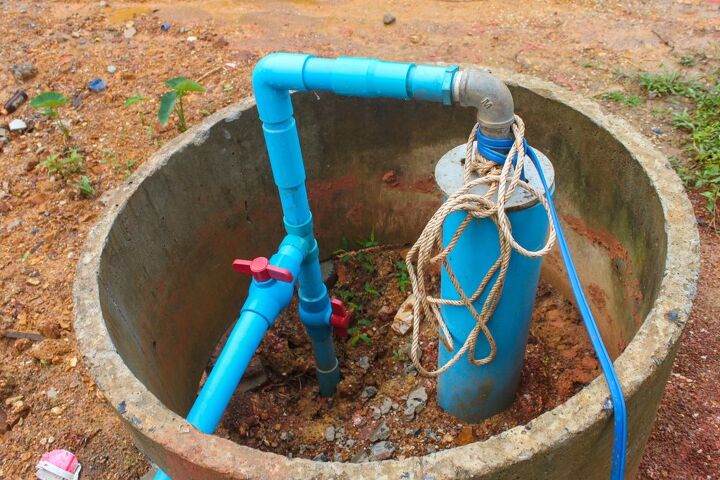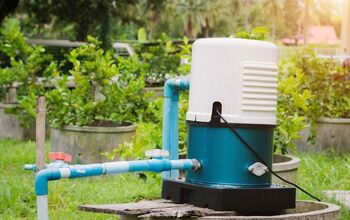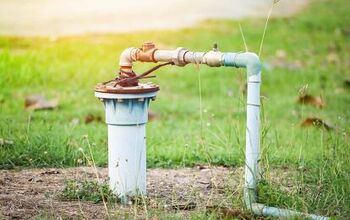How Much Does Well Pump Replacement Cost?

Eventually, your well pump is going to need to be replaced as they only last for a certain amount of time. Or, perhaps you’ve one a few updates and need an upgraded pump. Regardless of the circumstances, you will need to know how much it is to replace your well pump.
The average well pump replacement cost is $1,350 including the pump and labor. You can expect to pay $75 per hour in labor for professional well pump removal and replacement. It can cost another $200 on average if you need to replace your pump motor.
The price of replacing a well pump is determined by the pump’s type, depth, location, and well size. In this cost guide, we will cover all the cost aspects with different types of well pumps, as well as talk about the difference between the types of pumps. Also, we’ll talk about how to hire a pro, so you get the best value for your money.
Average Well Pump Prices
Average Cost | |||
Low | National Average | Average Range | High |
$100 | $925 – $2,483 | $1,676 | $3,000 |
A new well pump costs between $925 and $2,483, depending on the type you’re getting, including the price of labor. However, on average, most people pay about $1,676. The cost is determined by the size and type of well pump you decide to get and also if you hire a professional.
Without the price of labor, the pump itself runs between $100 and $1,200. Again, it depends on the type you go for and the size. For instance, you’ll pay a lot more for a solar pump than you would for a submersible pump or hand pump.
Well Pump Cost By Type
Well Pump Cost By Type | ||
Type | Price | Average Lifespan |
| Jet Pump | $270 – $745 | 10 years |
| Submersible Pump | $200 – $2,500 | 10 – 15 years |
| Solar Powered Pump | $3,000 – $4,000 | 15 – 20 years |
| Hand Pump | $150 – $300 | 15 years |
As we just mentioned, the price for your well pump will highly depend on the type of pump that you get. Check out the above table that we created so that you can compare prices.
Additionally, below, we’ve listed each type and dove into a bit further detail to break the price detail down a bit more. That way, you can see what to expect on the low end and what to expect on the higher price end.
Jet Pump Prices
Expect to pay around $270 for shallow well pumps (25-feet or less) with smaller motors and cheaper materials, like thermoplastic. Deep-well motors (up to 150 feet) with higher quality materials like cast iron will have a rough cost of between $675 to $745.
Jet pumps come in cast iron, stainless steel, carbon-ceramic, and thermoplastic. Most jet pump motors range from between one-half and two horsepower.
Shallow well pumps (25 feet or less) using smaller motors and less expensive materials like thermoplastic should cost approximately $270.
Submersible Well Pump Cost
Lower-horsepower submersible pumps cost on average $475, or between $200 and $500. The most powerful ones cost between $700 and $1,200. Many submersible pumps also need extra plumbing, which raises the overall cost of installation. Depending on the complexity of work, adding new pipes might cost anywhere from $250 to $2,500.
Submersible pumps range in horsepower from three-quarters to five horsepower and are made of cast iron or stainless steel. They also meet the same cost-to-replace criterion as jet pumps; however, they are often more costly.
These types of pumps are more dependable and quieter than jet pumps, despite their greater price. Submersible pump installation costs vary depending on the well size, material, and motor size.
Solar Powered Well Pump Cost
Both plastic and stainless-steel enclosures are available for solar pumps. Stainless steel versions are more expensive, but they last longer. Pumps that pump water from both shallow and deep wells will cost roughly $2,000 in basic setups.
High-end versions will pump at a greater gallon-per-minute pace from a range of well depths. Between $3,000 and $4,000 will be spent on these pumps.
Hand Pumps
Plastic, cast, and stainless steel hand well pumps are all available. Shallow plastic pumps are inexpensive, starting at roughly $150. Depending on the design and size of the well, larger, stainless deep well pumps might be more expensive. Hand pumps are extremely demanding, yet they work regardless of the weather or availability of utilities.
Well Pump Replacement Cost Factors
Replace vs. Repair Costs | |
Replacement Cost | Repair Cost |
| $925 – $2,483 | $300 – $1,300 |
The cost of replacing a well pump can range from $200 to $5,000, with the majority of households estimating a cost of $925 to $2,483. The cost of a replacement depends on a number of things. Here are some factors that may influence the cost of your new pump.
- Size of the well. Your replacement prices will be determined by the size and depth of your well. Pumps are easier to install in shallow wells than in broader, deeper wells. Shallow pumps are appropriate for wells less than 25 feet deep since they are less expensive. For wells up to 150 feet deep, deep pumps are required. A deep pump will cost more to buy and install.
- Type of Pump. The type of pump you use has a significant impact on the final cost. Jet pumps are easier to remove and install than submersible pumps because of the way they are built.
- Method of replacement. Hiring a professional will be more expensive than doing it yourself. It’s recommended to employ a local specialist unless you’ve replaced and installed a well pump before. Pump repairs might be highly costly if you try to fix them yourself.
- Issues with the pressure tank. A pressurized storage tank is where most wells supply water. A malfunctioning tank might cause problems with your pump or well. It costs between $800 and $3,800 to replace your storage tank.
Cost To Repair Well Pump
When should a replacement be expected? A comprehensive pump replacement may be required if there are significant mechanical, engine, or well difficulties. A simple pump repair generally fixes minor hardware damage, minor motor troubles, and minor well difficulties. The average cost of a water pump repair is between $300 and $1,300 for most households.
Jet Pump Upgrades
Instead of replacing a failing jet pump, homeowners may choose to replace it with a more contemporary submersible pump. Changing from an outdated jet pump to a submerged model will benefit your house in a variety of ways. Here’s a rundown of the advantages of switching to a submersible pump:
- Upkeep is required. Self-priming submersible pumps need less maintenance and wear and tear.
- Pressure is applied right away. Because they don’t work against gravity, submersible pumps build pressure 30 percent faster than jet pumps.
- Efficiency in terms of energy. Submersible pumps are more energy-efficient and quieter than jet pumps. If your well is close to your home, noise might be an issue.
- Expenses. Submersible pumps are totally sealed, which reduces the need for maintenance and lowers operating expenses. Submersible pumps are more expensive up front, but they save money in the long term by reducing repair and energy expenses.
What Are Well Pumps?
Well pumps are machines that pull water from a well by suction or pressure. Well pumps are divided into two categories: (1) those that are used to pump water and (2) those that are used to pump water
- Pumps that are submersible and have constant pressure. These pumps are submerged in the well and use pressure to force the water upwards. Water is moved via submersible pumps, which are watertight and employ direct pressure. This procedure is more effective than suction. Corrosion occurs more quickly in underwater pumps than in other models.
- Pumps with jets. Jet pumps function similarly to a straw. To pull water from a well, these pumps utilize suction and pressure. Many jet pumps are designed to be used in both deep and shallow wells.
How Do The Well Pumps Work?
There are several choices when it comes to well pumps, so there’s a few different ways that these work:
- Hand pump: To pull water from a well, hand pumps employ a hand-cranked lever. This sort of pump is beneficial in locations where there is no electricity, but it may be exhausting.
- Solar pumps: Solar well pumps rely on the sun to power a motor that takes water from a well. The effectiveness of solar pumps might be reduced by cloudy or gloomy weather.
- The majority of contemporary well pumps are powered by electricity: When a water supply is turned on, well pumps do not run continually. Instead, they transport the water to a holding tank. The pump operates and adds additional water when the water pressure in the tank dips below a specified level. Both submersible and jet pumps can be used in deep and shallow wells.
Difference Between Deep Wells And Shallow Wells
When it comes to replacing, repairing, or installing a pump, the depth of your well is crucial. Here’s a breakdown of the variations between different well depths.
Well pumps, both submersible, and jet are suitable for a wide range of well depths. If your well is deeper, you’ll need a larger pump motor, which will raise your overall expenditures.
Pump motors can cost anything from $100 to $300 or more. For shallower wells, hand and solar models are preferable. Some solar designs can handle deeper wells, but they will cost more.
What About Off The Grid Pumps?
For off-the-grid pump installations, the best choices would be solar or hand-crafted. There are some of the benefits of using off-grid pumps:
- Efficiency in terms of energy. Because hand and solar pumps do not require electricity to operate, they are incredibly energy efficient.
- Installation is simple. Hand and solar units, in most circumstances, do not need substantial installations like jet and submerged pumps.
- Hand and solar pumps are fantastic for outbuildings and other non-essential water sources, but they might make it difficult to use water in the home. Before you build an off-the-grid pump, make sure you know how much water your house uses.
Signs You Need A New Well Pump
Filtered water, loud noises, fluctuating pressure, the air in your faucets, and unexpected rises in water bills are all symptoms that your well pump needs to be replaced.
Electrical or mechanical issues frequently cause pump difficulties. If you’re having any of these problems, it’s a good idea to contact a professional. A pump expert will be able to identify the issue and recommend a suitable remedy.
Find out how to prime a well pump.
Why Hire A Professional?
It is critical to hire a professional to maintain your well pump for a variety of reasons. An expert will identify the issue and recommend the best course of action. If you don’t know the depth of your well or what type of pump you currently have, hiring an expert is an excellent choice.
Pump difficulties include issues with motor starting and shut-off, as well as a lack of water pressure. Electrical faults might cause these issues, which may necessitate assistance from the power provider if the voltage is too low. Well pump troubles are typically a mixture of electrical and water concerns, which can be deadly if you lack the proper knowledge.
The pump and pipes may need to be removed from the well on occasion. Submersible pumps are the most typical example of this. To remove the pump, professionals typically utilize a derrick truck or a puller machine.
Related Questions
How long do well pumps last?
A submersible well pump may last up to 15 years if properly maintained; however, it might be difficult to tell how old your well pump is if it was installed by a previous homeowner. Above-ground jet pumps, which are most typically utilized with shallow wells, have a 10-year average life duration. Is a well pump covered by homeowners insurance?
Does home insurance cover well pump repair?
Yes. If a covered risk causes the failure of your water well pump, your homeowner’s insurance will pay the costs. Basic home insurance covers the expenditures if your well pump fails due to a windstorm, lightning, fire, or any of the 16 identified dangers.
Do well pumps need maintenance?
When constructing a well, installing a pump, or servicing the system, always hire professional or qualified water well drillers and pump installers. A bacterial test is advised as part of an annual well-maintenance inspection. Most professionals will have package deals that you can buy so that you get the best value for your money.
Related Articles

Heather is a passionate writer who loves anything DIY. Growing up, she learned everything from home repairs to design, and wants to share her tips with you. When she's not writing, she's usually hiking or searching for her next DIY project.
More by Heather Robbins


























